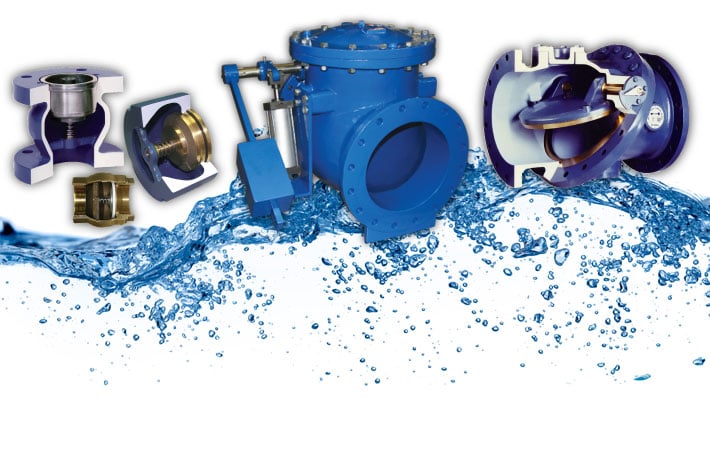
Check valves are simple valves. They use forward flow to open the valve, then automatically close when flow stops, preventing reverse flow from making its way back through the valve. They don’t require power to function, and they don’t require a whole lot of attention or maintenance. They do get a lot of attention, however, when they slam.
A check valve relies on gravity and/or reverse flow to close completely. Opportunity for check valves to slam frequently occurs at pump shutdown. When a pump stops, gravity and reverse flow slam the check valve shut. Because fluid is non-compressible, it creates a pressure or shock wave (water hammer). The fluid continues to flow back and forth until friction losses cause the wave to settle.
Slamming check valves cause serious pressure surges in a system that rattle pipes and damage equipment. Some people assume that’s just what check valves do. "No matter what, they’re going to slam." But that’s just not the case. Usually, the real cause of these problems stems from poor sizing and selection, not the type of valve itself.
Oftentimes check valves are selected based on the pipe size and the desire for the largest Cv possible. (CV stands for “coefficient of flow” for valves and demonstrates a valve’s capacity for liquid to flow through it.) Of course you want the ability to put as much fluid through the valve as possible, right? Makes sense, except this completely disregards the fact that flow conditions determine the internal performance of a check valve because the disc is directly in the flow path.
If there is not enough flow to keep the valve fully open with the disc reaching the ceiling of the check valve, the disc will move up and down, resulting in pre-mature wear, potential for failure, and a higher pressure drop.
For proper check valve selection, consider the following:
Selecting a valve of the proper size will have an impact on the amount of water hammer felt by the piping system.
Another solution to slamming check valves is to look at the type of check valve used in the application. Silent, ball, and resilient hinge are alternatives to the traditional swing check valve. They each carry different characteristics with varying degrees of pressure drop and closure speed.
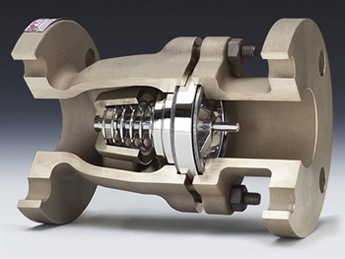
Silent Check Valves
Silent or spring –assisted check valves do not rely on gravity or reverse flow to close. Instead, the spring closes in about one-tenth of a second, the valve before reverse flow has an opportunity to slam the valve shut. It is able to close quickly because it has a shorter distance to travel than the flap on a traditional check valve.
This video from DFT illustrates how pressure spikes in the system are greatly reduced with a silent check valve.
Ball Check Valves
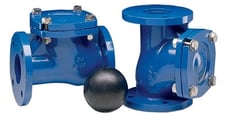
Ball check valves are economical and very simple valves. They sometimes utilize a rubber coated ball that floats up and out of the way while flow passes through the valve, and seats when flow stops. This particular valve closes slowly, so the potential for slamming is high.
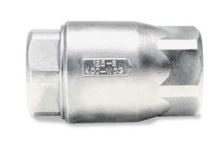 There are other styles of ball check valves that work similarly to silent or in-line check valves. These are called cone check valves.
There are other styles of ball check valves that work similarly to silent or in-line check valves. These are called cone check valves.
Resilient Hinge Check Valves
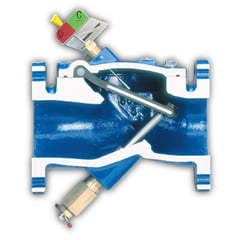
Resilient hinge check valves are very similar to the traditional swing check valve. The major difference is that a rubber molded disc flexes up and out of the way when fluid flows through the valve. The flap does not rotate around a hinge pin.
It has a shorter stroke than a traditional swing check valve, reducing the closing time of the valve and minimizing the potential for water hammer to occur.
Each of these valves have different characteristics, features and benefits that should be carefully selected for just the right fit into a system. If you’re experiencing issues with a check valve or need to select a new one for your process, talk to an engineer experienced in selection/sizing of these valves. Doing so will help your system perform at its highest efficiency while reducing slam and requiring less maintenance.
These Stories on Valves
Headquarters and Service Center
Located outside Green Bay, WI
707 Ford Street
Kimberly, WI 54136
920-733-4425
OptiFlow Design and Build Center
1002 Truman Street
Kimberly, WI 54136
920-733-4425
Burnsville Service Center
12265 Nicollet Avenue
Burnsville, MN 55337
952-444-1949
Grand Rapids Service Center
26489 Industrial Blvd
Cohasset, MN 55721
952-444-1949
© Copyright 2024. Crane Engineering. All Rights Reserved. Privacy Policy.